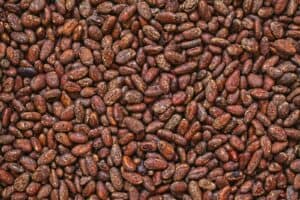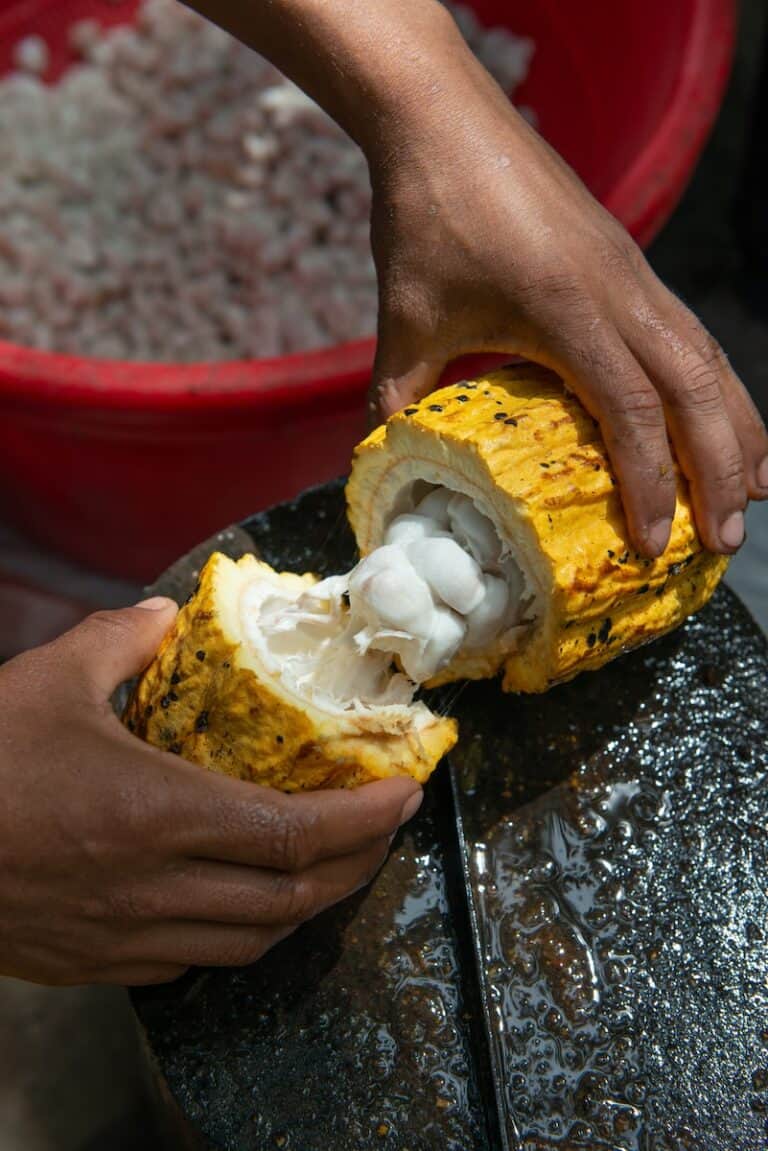Ever wondered how are cocoa beans harvested? I’ve always been curious about the process, especially given that it’s the main ingredient in the creation of one of my favorite treats – chocolate. Well, it all starts with cocoa trees and their fruit, the beautiful cocoa pods. It’s from these pods that we eventually get the cacao seeds, aka cocoa beans, which later transform into delicious chocolate bars.
Cocoa trees grow in tropical climates around the equator, with most of the world’s cocoa production coming from West Africa. Cocoa farmers tend to these trees, nurturing them as they produce colorful cacao pods. The pods grow directly on the trunk and older branches of the tree. After a period of about five to six months, the ripe pods are ready to be harvested. Since ripe and unripe pods often share the same branch, harvesting cocoa beans is predominantly done manually. Farmers usually use a blade, called a machete, to carefully remove the ripe pods without harming the tree or any neighboring unripe pods.
Once the cocoa pods are harvested, they’re split open to reveal the wet beans, which are surrounded by a sweet, pulp-like substance. The harvested beans undergo a fermentation process that is crucial for developing the chocolate flavor we all know and love. Traditionally, farmers spread the wet beans out on banana leaves, allowing them to ferment and dry naturally under the sun for about a week. This process can also be done using modern equipment to control factors such as temperature and humidity. After drying, the cocoa beans are ready to be processed further into cocoa powder, cocoa butter, and, of course, the chocolate treats we adore.

How Are Cocoa Beans Harvested: The Harvesting Process of Cocoa Beans
Harvesting cocoa beans is a vital step in the process of making chocolate bars. It begins with the cocoa tree, which produces cacao pods that contain the valuable cacao beans. Let’s explore the different stages of how cocoa beans are harvested to better understand the crucial role they play in the creation of our favorite treats.
Explore the rich history and cultural significance of Chocolate in Ancient Civilizations to uncover its role in early societies.
Cacao trees thrive in warm, tropical climates, particularly those found around the equator. On cocoa farms, these trees are carefully cultivated, and their pods are monitored to ensure they ripen properly. The process of growing and maintaining cocoa plants is quite labor-intensive, making the role of cocoa farmers crucial in ensuring the sustainability and quality of this delicious commodity.
In general, cocoa beans grow within large, colorful cocoa pods that hang directly from the trunk and branches of the cocoa tree. When these pods reach maturity, usually after 5 to 6 months, they are considered ripe and ready for harvest. Identifying the ripe pods is essential, as only they contain the high-quality cocoa beans necessary for making cocoa powder and cocoa butter.
Harvesting cocoa beans is predominantly done manually, requiring cocoa farmers to use sharp tools, such as machetes or specialized knives, to remove each cacao pod from the tree. It’s critical not to damage the tree itself during this process, as cocoa trees can continue to produce pods for years to come.
Enhance your culinary experience with our guide to finding Perfect Chocolate and Wine Combinations that will delight your palate
Once the harvested pods are collected, the next step is to extract the wet beans inside each cacao pod. Farmers use wooden mallets or other tools to crack open the tough outer shell of the cocoa pod, revealing a mass of wet beans covered in a white, pulpy substance. These wet beans are scooped out and prepared for the essential fermentation process.
Fermentation of the cacao seeds typically takes place in wooden boxes, banana leaves, or piles on the ground. The wet beans are left to ferment for about 5 to 7 days, during which natural microorganisms and enzymes break down the surrounding white pulp. The discarded husks are often returned to the soil as compost, promoting sustainable farming practices with minimal waste.
At the end of the fermentation process, the once wet beans have considerably changed in both texture and color, developing a richer flavor in the process. These cocoa beans are now ready to be dried, typically by laying them out on trays or bamboo mats in the sun for approximately 7 to 14 days. Finally, the dried cocoa beans are packed into sacks and shipped off to factories, where they’re transformed into delicious chocolate bars, cocoa powder, and other cocoa-based products.
In summary, harvesting cocoa beans is a labor-intensive yet essential process that involves many steps, including identifying ripe pods, harvesting cocoa pods manually, extracting wet beans, fermentation, and drying. This complex process ultimately leads to the delectable cocoa products we enjoy today.
Importance of Proper Harvesting Techniques

When it comes to understanding how cocoa beans are harvested, it’s crucial to emphasize the importance of proper harvesting techniques. The quality of cocoa beans, which are the main ingredient in chocolate bars, cocoa powder, and cocoa butter, depends heavily on the methods used to harvest and process them.
A primary step in harvesting cocoa beans is selecting the ripe cocoa pods from the cocoa tree. It’s essential to only pick ripe pods, as unripe or overripe ones can negatively impact the quality of the final product. Cocoa farmers often rely on their keen eye and experience to identify the ripe pods based on their color, size, and shape.
Once the ripe cocoa pods are identified, harvesting involves removing them from the cacao tree with care. Cocoa trees can be delicate, so it’s important to harvest cacao pods manually using machetes or other sharp tools designed for this purpose. This helps to prevent damage to the cocoa plants and ensures the sustainability of cocoa farms in the long run.
The harvested pods then need to be split open to extract the wet beans inside. This process is commonly done by using a machete and requires precision to avoid damaging the valuable cacao beans within the cocoa pod. The wet beans are then scooped out from the cacao pod and prepared for the fermentation process.
Discover creative ideas for unforgettable events with our tips on choosing the best Chocolate Party Favors for your guests.
Fermentation is a critical step in cultivating cacao as it helps to develop the beans’ flavor profile and remove the bitter taste characteristic of raw cacao seeds. The wet beans are typically placed in large containers or piles, covered with banana leaves, and left to ferment for a few days. The fermentation process requires proper monitoring and turning of the beans to ensure even fermentation and temperature distribution.
After fermentation, the cocoa beans are dried, a process that involves laying them out in the sun to remove moisture and prevent spoilage. Proper drying helps preserve the desirable flavors and ensures the beans are suitable for further processing into cocoa powder, cocoa butter, and chocolate bars.
In conclusion, proper harvesting techniques are vital for maintaining the quality of cocoa beans and allowing cocoa farmers to sustain their livelihoods. Careful attention must be paid to:
* Selecting ripe cocoa pods
* Harvesting pods gently and manually
* Extracting wet beans precisely
* Monitoring the fermentation process
* Employing proper drying methods
By ensuring these elements are executed well, we can secure the availability of high-quality cocoa products for years to come.
Final Thoughts
I’ve explored the process of how cocoa beans are harvested, and it’s clear that it’s a labor-intensive and intricate process. Cocoa farmers play a crucial role in the production of chocolate bars and other products that use cocoa butter and cocoa powder.
Cocoa beans grow on the cocoa tree, specifically in the cacao pods. When these pods ripen, farmers harvest cacao pods manually, as the ripe pods need to be separated from the unripe ones. This selective process ensures only mature cacao beans make it to the next stage of production.
After the cacao pods are harvested, they’re opened to extract the wet beans inside, also referred to as cacao seeds. The fermentation process follows, which can take several days. This crucial step enhances the flavor profile of the cocoa beans and is typically done by placing the beans in banana leaves or similar materials to retain heat and moisture.
Cultivating cacao is not limited to harvesting cacao pods and processing cacao beans. Cacao trees require careful attention and maintenance to ensure a productive yield. This involves:
* Proper spacing and pruning of cocoa trees
* Protecting cocoa plants from pests and diseases
* Supporting cocoa farms with sustainable practices
Discarded husks from the harvested pods can be returned to the soil as a natural fertilizer, further promoting sustainability in cacao harvesting.
In conclusion, the journey from the cocoa tree to the final product shows just how vital the harvesting of cocoa beans is to the chocolate industry. The meticulous labor of the cocoa farmers and the various stages, from handpicking ripe pods to the fermentation process, ensure cacao beans possess the flavor and quality necessary for creating those delicious chocolate bars. The next time you enjoy a piece of chocolate, take a moment to appreciate the hard work and dedication that goes into harvesting cocoa beans.
Immerse yourself in the delectable comparison of Belgian and Swiss Chocolate to find out which variety stands out.
- How To Taste Chocolate
- How To Make Thick Hot Chocolate
- How To Make Christmas Hot Chocolate
- How To Make Christmas Chocolate Chip Cookies
- How To Make Chocolate Truffles For Christmas
- How To Color Chocolate
- How Long Does Chocolate Last
- How Is Chocolate Made
- How Does Chocolate Affect The Brain
- How Do You Make Chocolate Ganache
- How Do You Drizzle Chocolate
- How Chocolate Chips Are Made
- How Are Cocoa Beans Harvested
- How Are Chocolate Covered Almonds Made
